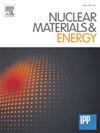W-Cr-Y SMART合金氧化相的稳定性
IF 2.7
2区 物理与天体物理
Q1 NUCLEAR SCIENCE & TECHNOLOGY
引用次数: 0
摘要
在钨中加入Cr和Y可以显著提高未来聚变反应堆第一壁的抗氧化性,从而降低挥发性WO3形成和放射性物质释放的风险。实验观察表明,在这些SMART合金中,钇促进了金属表面Cr2O3自钝化层的形成,然而,Y究竟如何做到这一点尚不清楚。因此,本研究利用密度泛函理论探讨了W-Y-Cr-O组成的化合物的相稳定性和钨中不同组分的溶液能量。模拟结果表明,Y2O3的形成有重要的热力学驱动力,特别是在钨体中由钇和氧溶剂化而成。这些观察结果表明,钇的作用可能是去除可能抑制铬从钨晶向表面扩散的氧。这一观察结果与实验研究一致,表明当合金中的氧钇比接近Y2O3的化学计量比时,合金中的抗氧化性就会发生。本文章由计算机程序翻译,如有差异,请以英文原文为准。
Stability of oxide phases in W–Cr–Y SMART alloys
The addition of Cr and Y into tungsten can dramatically increase the oxidation resistance of the first wall of a future fusion reactor, thereby reducing the risk of formation of volatile WO and the release of radioactive material. Experimental observations suggest that in these SMART alloys, yttrium facilitates the formation of a self-passivating layer of Cr2O3 at the metal surface, however, how exactly the Y does this remains unclear. Therefore, this work explores the phase stability of compounds consisting of W–Y–Cr–O and solution energies for the different components in tungsten using density functional theory. The simulations suggest that there is a substantial thermodynamic driving force for the formation of YO, especially from yttrium and oxygen solvated in bulk tungsten. These observations suggest that the role of the yttrium may be to remove the oxygen that may inhibit Cr diffusion to the surface from the tungsten grains. This observation is in accordance with experimental studies showing that the oxidation resistance in the alloy occurs when the oxygen–yttrium ratio in the alloy is close to the stoichiometric ratio for YO.
求助全文
通过发布文献求助,成功后即可免费获取论文全文。
去求助
来源期刊

Nuclear Materials and Energy
Materials Science-Materials Science (miscellaneous)
CiteScore
3.70
自引率
15.40%
发文量
175
审稿时长
20 weeks
期刊介绍:
The open-access journal Nuclear Materials and Energy is devoted to the growing field of research for material application in the production of nuclear energy. Nuclear Materials and Energy publishes original research articles of up to 6 pages in length.
 求助内容:
求助内容: 应助结果提醒方式:
应助结果提醒方式:


